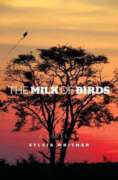
The Milk of Birds
Written by Sylvia Whitman
Atheneum Books for Young Readers, 2013, 384 pp.
ISBN: 978-1442446823
It is strange to think of all the people in the world. Most we do not know or ever see, but they grow up alongside us. Nawra, (p. 346)
Nawra is a 14-year-old Sudanese teenager involved in a “Save the Girls” project through a relief agency that pairs young women from war-torn Sudan with typical American girls. Her pen pal is K.C., who has learning disabilities that make her feel alienated from most of her peers. The two seem an unlikely pairing, and at first, they are. K.C. reluctantly gets involved with the project, propelled by her mother’s desire for K.C. to gain a greater understanding of the world. Nawra becomes involved because her friend, Adeema, brings her to the meeting at the IDP (internally displaced person) camp in Sudan. Adeema writes for Nawra, who is illiterate. K.C., who procrastinates for months before returning any letters, eventually becomes deeply involved in the events of Nawra’s life and the conditions in the Sudan. Both come to rely upon each other as confidantes and distance supporters for each other’s growth through their painful life circumstances.
The Milk of Birds is quite simply a beautiful story that presents readers with two stories that intertwine and remind us of the delicate balance that is often a part of life regardless of geographical or political location. Readers come to know about the devastation of Darfur and the Sudan as well as the stigma of learning disabilities through the letters and life narratives of these young women. As the stories on both sides of the written relationship unfold, readers are introduced to strong young women who find courage to face their individual circumstances—one horrific, the other perhaps less so but with the potential of long-lasting damage to the psyche. The author maintains a balanced approach to the painful stories with the use of humor by both the protagonists. The use of proverbs is a delightful addition to the text and could be very useful for reframing readers’ thinking about their circumstances. Equally important in the story are the two supporting friends, Emily and Adeema, who have significant roles to play and serve as a model of female friendships that weather the backlash that often accompanies alienation and stigmatization by peers.
The explanation at the end of the book of the connection to author Sylvia Whitman allows readers insight into Whitman’s purpose for writing and her writing process, which is as enlightening as the text itself. She notes her love of proverbs, which are sprinkled throughout the book, and make for excellent discussion with young people about the richness of language and the profound messages that can be relayed in shorter passages. Written for middle and high school students, The Milk of Birds would make a great companion to A Long Walk to Water (Linda Sue Park, 2011) or A Long Way Gone (Ishmael Beah, 2008) to address the topic of the Sudan and Darfur. It could also be used in a text set with books such as Make Lemonade (Virginia Euwer Wolff, 2006) and Child of Dandelions (Shenaaz Nanji, 2009) as a way of examining friendships across cultural borders.
Sylvia Whitman is a writer and writing specialist who lives in Arlington, Virginia and works at Marymount University. She has also taught undergraduate seminars on the Middle East and North Africa. The Milk of Birds is her first young adult novel, but she has written informational texts for young audiences about issues of war and poverty. More information about Whitman can be found on her website.
Holly Johnson, University of Cincinnati, OH
WOW Review, Volume VI, Issue 1 by Worlds of Words is licensed under a Creative Commons Attribution-NonCommercial-ShareAlike 4.0 International License. Based on work at https://wowlit.org/on-line-publications/review/vi-1/

Dear Ms. Wilson,
I would be grateful for some details – which are the facts that I neglected to look up, specifically on Wikipedia?
The novel was written in 2005 and I consulted countless books and other media in order to describe two Jewish families in the 1930s and 1940s as credibly as possible. A good deal of the two years of writing this novel (the German original being much longer than the American edition) was spent on research in Berlin and London. Before going into print, the finished novel was read and approved by two scholars with a degree in Judaism. One of them spent most of her life in Israel.
I am very sorry for any mistake which remained in the book, also for maybe not quite catching the spirit of being Jewish in Britain in the 1940s.
With best wishes,
Anne Voorhoeve